Film Chronicle
by dave heaton
Not sure why, but I've given myself a new year's resolution to write something about every film I watch this year, whether in the theatre or on DVD, whether I've seen it before or not. We'll see how well I keep this up…
JANUARY 2007
Winter Passing (2005) (DVD)
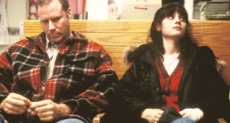
The two main characters driving the plot of this film seem like familiar enough types: a reclusive, JD Salinger-type author (how many of these are there in life compared to the movies?) and his daughter, the struggling actor who moved from rural Michigan to the Big Apple to pursue her dreams, only to wrap herself in a haze of self-destructive behavior. Luckily, the actors – Ed Harris and Zooey Deschenal, respectively – are talented enough (Harris' ridiculous hair aside) to keep us caring about what will happen, about whether the daughter will publish her parents' love letters to earn a buck, or better yet reconcile with her estranged, and strange, father. I say "luckily"…because following the plot along leads us to a supporting character that makes the whole film worthwhile. In the middle of what's mostly a drama (if only occasionally a heavy-handed one) is Will Ferrell, as funny as ever as an oddball named Corbit who lives with Harris (along with the writer's former student, recovering from illness, played by Amelia Warner). Corbit's a truly one-of-a-kind character: a Jesus-loving, eyeliner-wearing wanna-be rock star with his own uniquely slow style of speaking. Ferrell's in a way playing a typically outlandish character for him, but his performance is toned down, subtle even…and in that low-key side it contains a real emotional center. The feelings within come out most in a spellbinding, and still quite funny, scene where he goes to a local bar's open mic night and sings an Eagles song. Shyly, but with determination. It's not unlike his later performance in Stranger Than Fiction, the scene where he out-of-the-blue gives a sensitive performance of an obscure punk-pop song, revealing additional layers to his personality. That scene is even more riveting, but this scene in Winter Passing is remarkable in much the same way. Filmmakers should convince actors to sing more often…especially actors without perfect singing voices. Singing can reveal so much more than speaking, sometimes. – dave heaton
Idlewild (2006) (DVD)
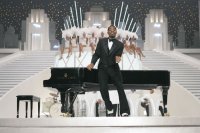
Idlewild begins with the camera entering a record as it begins to play. That's a key – this is an attempt to recreate visually what an Outkast album sounds like. So there's bright colors, unexpected animation, and characters that match the two MCs' personalities on record, these days. That is, Big Boi plays a character torn between the wild life and family life, and Andre 3000's playing a shy musician unsure of his place on the stage. And, just like on their recent albums, they play close friends who hardly ever appear in scenes together. And if The Love Below was Andre's Prince album, Idlewild is Outkast's version of a Prince musical: lip-synced but energetic musical performances, a thin plot, stiff acting, lots of style and glamour. Actually, it goes one better than the Prince films – the plot's not quite as thin, and not as tied to the songs. And the film as a whole does a better job of capturing the feeling of old Hollywood musicals, where everything's grand and romantic, and the spirit of the music lives through the film from beginning to end, even when dialogue lines make you groan. It certainly has more spark than most recent Hollywood musicals, partly because the music's hotter and partly because it absolutely isn't taking itself too seriously as a film. – dave heaton
Duelle (1976)

The part of Duelle - Jacques Rivette's 1976 film, screened recently at Philadelphia's International House, as part of the misleadingly titled "Early Rivette" series – that I keep thinking about is how the score is performed on screen, mostly by a lone piano player lurking in the background. Two people will be having a serious discussion in an empty room, and in the background a man will appear, sitting at a piano, watching them. As they talk, he plays. And then he'll disappear, as silence fills the air. This device of course highlights the theatricality of the basic form of film, but his presence is also quite eerie, fitting for a film where the main characters often seem to be going mad. Ostensibly a mythological tale about two goddesses battling for possession of a gem that would allow them to stay on earth longer, each manipulating humans to gain hold of the gem, the film plays out like a beautifully disjointed hybrid of film-noir scenes, including many that offer a deja-vu feeling of recognition. The camera at first follows the film's characters closely – at times, surprisingly so, like when we're following someone down a hallway and feel about to run into her. But as the film proceeds the shots seem further away, and we become more aware of the emptiness of these surroundings, of this Paris…and by relation the ghostliness of it. We become attuned to the movement of these few characters away from and towards each other, playing games of intimacy and withdrawal, across this blank stage of a city. - dave heaton
Street Fight (2005) (DVD)

A recurring image in Street Fight, Marshall Curry's documentary on the 2002 Newark, NJ mayoral race, is of Curry's camera getting pushed out of the way by an oncoming hand. Scenes like this make the first-person perspective of the film – complete with filmmaker's voiceover – seem necessary where initially it seemed clumsy. These scenes are also emblematic of the character of this political contest, as the film depicts it. To say the race between long-time Newark mayor Sharpe James and idealistic newcomer Cory Booker is contentious would be a major understatement. The title Street Fight may partially refer to Booker's grassroots, street-level campaign, run by walking the city's poorest neighborhoods block by block, while he himself is living in a housing project. But the film is mostly called Street Fight because this political battle has no rules, like a street fight. James is portrayed as willing to do anything, or say anything, no matter the truth, to stay in power. And the film soon becomes like a classic small man versus big operation story, with extra dimensions to it due to the way matters of race become a key concern even in this contest between two African-American men, appealing largely to African-American voters. - dave heaton
Talladega Nights: The Ballad of Ricky Bobby (2006) (DVD)
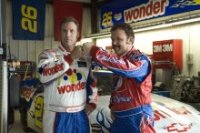
There's some genuinely absurdist, bizarre-for-a-Hollywood-comedy moments scattered throughout the Will Ferrell NASCAR comedy Talladega Nights: The Ballad of Ricky Bobby, including the gag about the sports announcer interviewing random people as if they were celebrities like Kenny Rogers, many of the antics of Ricky Bobby's French nemesis (played by Sasha Baron Cohen), and the way Ricky Bobby's two children, Walker and Texas Ranger, develop from know-it-all, arrogant brats into polite, erudite and conciliatory young men – a change not just to mimic their father's own maturation but also to suggest an alternate, more understanding course for American political leaders, for the US as a country. Film critics no doubt got a kick out of that slight sociopolitical side of the film, but those two child actors signify as well one of the film's main successes: the acting. The laughs here come not just from the writing, but from the just-right acting, including those kid actors (the younger one especially), and Cohen and Ferrell, but also, notably, John C. Reilly, who has a whole career as a comic actor lying in front of him if he wants it. - dave heaton
FEBRUARY 2007
Jesus Camp (2006) (DVD)

It's an interesting subject for a documentary – the rise of a certain type of Christian evangelical in the US, a form of Christianity that never mentions what most people think of as the tenets of the faith (love one another, judge not, etc.), instead framing the world as a war between the faithful and the faithless, and life as a constant battle to prove they're part of the first category, since their souls depends upon it. It's a religion that jibes all too well with the conservative political movement (witness the scene where a mother home-schools her son about how global warming doesn't exist). It's also a religion of torment – the most striking images in the film are of youth at "Jesus camp" crying and shaking in fits of turmoil, resembling living-dead characters from so many zombie films. Oddly though, the filmmakers, Amy Berg and Frank Donner, chose to score these scenes as if this were a horror film, with overbearing spooky music. It's one of the many ways they approach this subject matter with a clumsily-swung hammer instead of a thoughtful camera. The filmmakers wander from image to image throughout the film, letting scattered images – which in and of themselves don't say that much – stand in place of genuine context, background, or conversation about the issues at hand. So many questions linger at the end (how big is this Jesus camp? Are there others like it? How long have they been around? And on and on and on). The filmmakers' notion of a dialogue is continually returning to an Air America DJ giving a speech against this style of religion. But he's always talking at, not to, the Evangelicals…and he's not all that articulate about the matter in the first place. Jesus Camp feels like such a missed opportunity, like hearing snippets of a conversation that add up to nothing useful. – dave heaton
Manhattan Murder Mystery (1993) (DVD)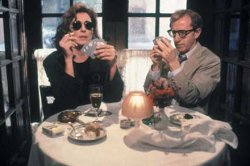
Manhattan Murder Mystery is considered a lesser Woody Allen film by critics, and the director himself: a genre exercise done as a lark. But it's one of my favorites, one of those 'comfort films' I turn to whenever I want to watch a movie that I know I'll enjoy every frame of. In tribute to classic detective films of the past, the mystery plot is revealed in a playfully screwball way, and is as entertaining and ludicrous as you'd want it to be. Allen and Diane Keaton's banter is funny and playful as well, and their depiction of a long-married couple quite sweet (reminiscent for me in some ways of Allen and Tracy Ullman in Small Time Crooks, another favorite 'lesser' Allen). And the hand-held camera work always surprises me – the camera moves loosely around the characters, as if studying them, and hides from them, as if eavesdropping… as if the camera itself was part of the mystery, part of the deception at hand. – dave heaton
The Adventures of Sherlock Holmes (1939), Sherlock Holmes Faces Death (1943), The Pearl of Death (1944), The House of Fear (1945), Pursuit to Algiers (1945) (VHS)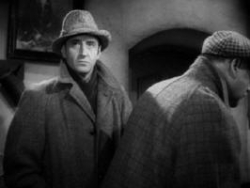
The first time I watched one of the Sherlock Holmes films featuring Basil Rathbone as Holmes and Nigel Bruce as Dr. Watson, I was too close to the original stories to enjoy it. I had just read The Hound of the Baskervilles for the umpteenth time (one of my earliest reading memories is of a dumbed-down-for-kids version of the same), and in comparison the film seemed rather silly. When recently watching their second film The Adventures of Sherlock Holmes, though, I was further from the actual stories, enough so to appreciate the detailed characterization of the two lead actors (Rathbone is the Holmes from the book, and Bruce's more humorous portrayal of Watson fits the format of a Hollywood film well), the fully realized setting of London, and the entertaining way in which the plot unfolds, whether it's completely true to the story or not. While at home sick I watched five of these films – some loosely based on Arthur Conan Doyle's stories and some not based on them at all – and thoroughly enjoyed each one. Adventures is probably the best, with the most convincing London setting, a surprisingly fallible Holmes, and excellent supporting actors, including Ida Lupino. But there's pleasures to be found in each of the others, from the country-house mystery The House of Fear to the espionage-on-a-cruise ship tale Pursuit to Algiers. I haven't yet experienced some of the odder and more propagandistic turns of the series, like Holmes going to Washington DC or Holmes fighting the Nazis, but these five all translated Sherlock Holmes into Hollywood-speak in truly entertaining ways.
The Science of Sleep (2006) (DVD)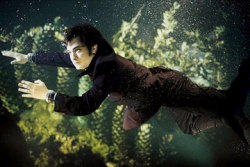
Within its story of a young artist/dreamer (Stèphane, played by Gael Garcia Bernal) who awkwardly approaches life, including the friend/neighbor/fellow artist he has a crush on (Stepanie, Charlotte Gainsbourg), there's ample opportunities for directory Michel Gondry to exercise his fondness for, and creativity with, old-school animation and special effects techniques. In Stèphane's dreams, inanimate objects come to life and he finds himself in bizarre situations. The creativity of these sequences is spellbinding, but not nearly as much so as in Gondry's music videos. The difference is that the best of his videos – The Chemical Brothers' "Let Forever Be", The White Stripes' "The Hardest Button to Button" – are all about imagination. In The Science of Sleep, bringing imagination to life is the backdrop, window dressing for a dull, hard-to-relate-to story about an artist who is so afraid of life that he can't relate to anyone or anything, so much so that he's impossible to stomach as the protagonist. That wouldn't be impossible if the film shined a critical lens on his eccentricity in any way – instead it acts like this is a by-product of his creativity, instead of the egomania (or if not egomania, insanity) that it resembles on screen. In that way the film furthers the notion that artists are by nature more "complicated" than everyone around them. It doesn't help that this dreamer's dreams are themselves dull, and don't resemble the language or logic of any dreams I've ever experienced. The most charming character in the movie was probably the toy pony that came to life – in other words, the most impressive aspect of the film was the animation techniques. And you can experience a lot more of those, in more exciting ways, in a lot less time in Gondry's music videos. Or in Eternal Sunshine of the Spotless Mind, which had more interesting ideas and people within it.
Copyright (c) 2007 erasing clouds |
|